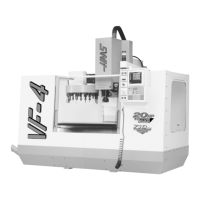305
PARAMETERS
June 1999
96-8000
LEAD S CREW C OMPENSATION
Separate lead screw compensation is provided for each of the X, Y, and Z axes. The operator-entered compen-
sation values are spaced at 0.5 inch intervals within the machine coordinate system. The compensation values
are entered in inches with a resolution of 0.0001 inch. The operator entered values are used to interpolate into a
table of 256 entries. The spacing between two entries in the table of 256 is defined by Parameter 58. The
entered values are limited to +/-127 encoder steps; so the limit in inches is dependent on Parameters 5, 19,
and 33.
Note that the first entry corresponds to machine position zero and subsequent entries are for increasingly
negative positions in the machine coordinate system. The user should not ever need to adjust the lead screw
compensation tables.
ELECTRONIC T HERMAL C OMPENSATION
When ballscrews rotate they generate heat. Heat causes the ballscrews to expand. In constant duty cycles as
in mold making the resultant ball screw growth can lead to cutting errors on the next morning start up. Haas'
new ETC algorithm can accurately model this heating and cooling effect and electronically expand and
contract the screw to give near glass scale accuracy and consistency.
This compensation is based on a model of the lead screw which calculates heating based on the distance
traveled and the torque applied to the motor. This compensation does not correct for thermal growth due to
changes in ambient temperature or due to part expansion.
Electronic thermal compensation works by estimating the heating of the screw based on the total amount of
travel over its length and including the amount of torque applied to the screw. This heat is then turned into a
thermal coefficient of expansion and the position of the axis is multiplied by the coefficient to get a correction
amount.
If the machine is turned off when there is some compensation applied (due to motion and heating of screw),
when the machine is turned back on, the compensation will be adjusted by the clock indicated elapsed time.
SPINDLE H EAD T HERMAL C OMPENSATION
This feature integrates spindle speed over time and builds a model of thermal growth. As the model shows the
spindle head warming up, the control adjusts the Z axes to compensate for thermal growth.

